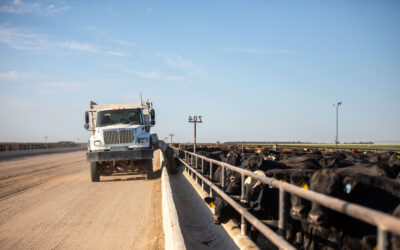
Plan, monitor and cool it
by Kylee Kohls
It’s a hot topic every summer.
“Heat stress is the largest impediment to efficient animal agriculture,” said Rob Rhoads, Virginia Tech. He presented with University of California-Davis colleague Frank Mitloehner for a symposium on the topic at the American Society of Animal Scientists annual meeting in July.
Rhoads focused on what happens inside cattle as they respond to a detrimental heat load.
“Cattle start to change their nutrient partitioning and their fuel selection, in terms of fatty acids versus carbohydrates or glucose,” he said. “It takes a lot of energy for muscle to grow and for lean tissue accretion—during heat stress, we’re seeing changes that prevent the animal from using fuel substrates for energy use and protein deposition appropriately.”
The metabolic impact of heat stress is more than reduced feed intake, once considered the main driver, Rhoads said.
Take gut health for example. Excessive panting and drooling from heat stress can upset the gut or even lead to internal leaks and rumen acidosis. Immune challenges initiate an inflammatory response and more injury risk.
Mitloehner addressed the impact on carcass characteristics.

“We found that animals provided with shade have a much higher quality grade,” he said of earlier research. “We see about twice as many Choice carcasses in shaded versus unshaded cattle.”
Rhoads said preparing cattle for prolonged heat or heat waves involves thresholds drawn from resources such as the Temperature Humidity Index (THI) that predicts when that combination will affect animals.
The longtime established 72°F threshold for heat stress has been lowered to 68°F based on recent Arizona research, he noted, partly because more efficient animals produce more metabolic heat.
Two resources developed in Australia include the heat load index for gauging environmental impacts, and the panting score system that correlates with body temperature.
“Right now the biggest thing that cattle producers can do to combat heat stress really revolves around infrastructure and management decisions,” Rhoads said.
Providing shade and cool water, and only feeding or working cattle in the cool of the day can prevent solar radiation and the damaging effects from an elevated heat load.
Cool water is especially critical, particularly if it warms to more than 95°F, Rhoads said. Such temperatures not only impair the ability to dissipate heat, “but then they also want to drink less…that’s going to negatively impact their heat load and affect how the animals respond to heat.”
Shade and ventilation systems have a profound impact on feedyard cattle and profitability, Mitloehner said: “In fact, providing shade led to an $18 (per head) improvement in performance and carcass characteristics.”
While that dollar improvement is the same as the expense to set up, that cost only occurs once so the improvement breaks even after one year. The West Texas shade study showed decreased heat stress and increased performance of Angus cross cattle, and eventual financial advantage for feedyards.
“What’s more important than anything else is what these shades do to the soil surface temperature,” Mitloehner said. “Because what shades really do is not so much cooling the ambient air—the air you would measure with a normal thermometer—but what they do is they cool the surface temperature of the ground.”
Heat stressed cattle will stand to dissipate heat, but if the ground is half the air temperature because of shades, they will lay down. “That’s why they work—and dome shades do an even better job than the metal type shades,” Mitloehner said.

“When I did my PhD almost 20 years ago in West Texas, people felt that there’s no need for shades, and they found all different kinds of reasons as to why one wouldn’t need shade. I disagreed back then, and I even more disagree today because I find profound improvements,” he said.
Seeing shades benefit Arizona, New Mexico and some California feedyards, the researcher said he believes they could have great impact in Texas, Kansas, Nebraska and Oklahoma, too.
“If people have doubts, then there’s a very simple way of finding out. Install shades in four of your pens,” he suggested, “and you’ll see that not just your cattle, but you will like it as well.”
you may also like
CAB Sets Sales Records, Sees Historically High Brand Acceptance Rates
In an otherwise tough time in the beef business, sales and supply records have been a bright spot. The positive numbers mean that quality beef production has not let up, and beef demand is holding. Consumers have proven the value proposition: the good stuff is worth a little more money, for a better eating experience.
Feeding Quality Forum Dates Set Earlier in August
When you’re feeding cattle, it counts to keep track of every calf, pound and dollar. Beyond the event’s educational sessions, networking between segments of the beef supply chain is invaluable—from feeders and cow-calf operators to allied industry and university researchers.
Every Issue Has Its Moment
Progress happens when people are at the table, engaged and committed to action. With a vested interest in the industry’s future, CAB is leaning in on conversations surrounding evolutions in meat science.



